








BY RYAN XU & SID SHUKLA
In response to the growing national concerns surrounding immigration enforcement, Sacramento Country Day has taken quiet but deliberate steps to prepare faculty for the unlikely event that agents from the U.S. Immigration and Customs Enforcement (ICE) appear on campus.
On Jan. 20, the day he was inaugurated,
President Donald Trump signed Executive Order 14159, titled “Protecting the American People Against Invasion,” instructing federal immigration authorities to crack down on undocumented individuals living in the United States. The executive order stated that such individuals “present significant threats to national security and public safety” and have committed “vile and heinous acts against innocent Americans” such as “espio-
nage, economic espionage and preparations for terror-related activities.”
In California, Trump’s immigration policy against these perceived threats to national security has manifested in a series of raids.
On April 7, ICE agents attempted to gain access to students in two Los Angeles schools, according to the Los Angeles Times. The agents requested to interview four students between first and sixth grade at Russell
Elementary School but were denied access by the principal. The same day, federal agents attempted to interview a sixth grader at Lillian Elementary School. These incidents renewed national attention to a pressing question: Do schools remain the safe havens that they once were understood to be?
BY KATE BARNES
On May 7, Country Day students senior Griffin Misquitta, junior Isaac Reynen, sophomore Matthew Inman and freshman Alexis Schroeder participated in a round table facilitated by The Octagon. The topic of discussion was political issues in the context of education, specifically regarding an executive order released on March 20 by the Trump Administration titled “Improving Education Outcomes by Empowering Parents, States and Communities” and the dismantlement of the Department of Education (ED).
Established by Congress in 1980 under President Jimmy Carter as a way to consol-
High school students will follow a minimum day schedule on Wednesday, June 4, for the final day of school. Classes for all students except seniors will run from 8:30 to 11 a.m. Seniors are expected to arrive at 11 a.m. Graduation rehearsal for all students will begin at noon.
idate federal involvement in education into one department, it was motivated in equal parts by the Civil Rights Act, President Lyndon Johnson’s “War on Poverty” and rapid Soviet Union advancements in science and technology; nationally, U.S. students were falling behind.
ED is the primary executive agency charged with overseeing federal education laws and programs. According to Harvard EdCast, a Harvard Graduate School of Education website, the department “plays a key role in distributing federal funds, enforcing civil rights laws and conducting educational research,” though providing less than 10% of K-12 funding. The ED also manages programs such as the Pell Grant, PLUS loans and student loans.
On June 5 at 7 p.m., the class of 2025 will graduate from Sacramento Country Day at Edwards Plaza. All grade levels are invited to join and celebrate the conclusion of the 2024-2025 school year. Congratulations seniors! Find out where the class of 2025 is headed next on pages 8–9.
According to the ED website, “the department does not establish schools and colleges, develop curricula, set requirements for enrollment and graduation, determine state education standards or develop or implement testing.”
An executive order is defined according to the American Civil Liberties Union as a “written directive, signed by the president, that orders the government to take specific actions.”
While executive orders cannot override federal laws and statutes, they can instruct a department to, for example, prioritize a new policy or implement a new rule.
The term diversity, equity and inclusion (DEI) was coined in the aftermath of the social justice movements of the 1950s and 60s.
The aim of DEI programs, defined by the Mer-
riam-Webster Dictionary, is to “[establish] a group culture of equitable and inclusive treatment [for] people who have historically been excluded or discriminated against.”
Q: In his executive order, President Trump directed former World Wrestling Entertainment CEO Linda McMahon, his appointed Secretary of Education, to dismantle the ED, stating that “the experiment of controlling American education through Federal programs and dollars … has plainly failed our children, our teachers, and our families.”
What is your opinion on the order?
ROUNDTABLE page 3 >>
INSIDE ISSUE the
“Sincerely,” REVIEW
Read a review of the newest Kali Uchis album released on May 9. (PAGE 15)
PHOTO COURTESY OF KALI UCHIS

EDITORS-IN-CHIEF
Ava Eberhart
Saheb Gulati
Zema Nasirov
Garrett Xu
COPY EDITORS
Eesha Dhawan
Saheb Gulati
Ryan Xu
NEWS EDITOR
Aaryan Gandhi
FEATURE EDITOR
Eesha Dhawan
SPORTS EDITOR
Andrew Burr
A&E/OPINION EDITOR
Kate Barnes
TECHNOLOGY TEAM
Ava Eberhart, manager
Daniel Holz
Rebecca Lin
Ryan Xu
PHOTO EDITOR
Rehan Afzal
PAGE EDITORS
Rehan Afzal
Andrew Burr
Jesse Dizon
Ava Eberhart
Aaryan Gandhi
Anisha Mondal
Anika Nadgauda
Zema Nasirov Garrett Xu
BUSINESS STAFF
Aaryan Gandhi, manager
SOCIAL MEDIA STAFF
Ava Eberhart, co-editor
Anika Nadgauda, co-editor
REPORTERS
Noor Alameri
Lukas Chung
Ava Levermore
Vivian Li
Parsiny Nijher
Maggie Nuñez-Aguilera
Jacob Rabe
Jack Robinson
Maddy Schank
Sid Shukla
Zachary Vando-Milberger
Andrea Yue Ryan Xu
PHOTOGRAPHERS
Rehan Afzal, editor
Simon Lindenau
Anika Nadgauda
Zema Nasirov
MULTIMEDIA STAFF
Ryan Xu, editor
Andrew Burr
Jesse Dizon
Anika Nadgauda
GRAPHIC ARTISTS
Claire Gemmell
Anika Nadgauda
Zema Nasirov
Gavin Wang
ADVISER
Andrea Todd
The Octagon is the student-run newspaper of Sacramento Country Day high school. The print edition is published eight times a year, and the website is updated regularly. The Octagon is committed to unbiased and comprehensive reporting, serving as a source of reliable information for SCDS students and the school community. The Octagon will publish all timely and relevant news deemed appropriate by the editors-in-chief and adviser. We seek to highlight high-school-related events and spotlight the voices of those with a story to share. Further policies can be found on our website or by scanning the QR code below.

BY VIVIAN LI
As the end of the Sacramento Country Day school year approaches, new positions have been announced for Student Council, The Octagon and The Medallion for the 2025-26 school year.
The high school Student Council — responsible for managing school events — has determined which students will take the place of the current student body leaders.
President senior Saheb Gulati and vice president senior Garrett Xu selected juniors Gavin Wang and Liam Donohue to become the student body president and vice president, respectively.
“They have it in them to uplift the campus, whether it’s the demeanor, conduct of morning meetings or interaction between classmates,” said Gulati. “I’m really hoping that the entire student body takes what we’ve accomplished this year to a higher level.”
Student Council adviser Patricia Jacobsen, who is also the high school dean of student life, wishes to reinforce existing traditions at Country Day that have been in place for years.
“I’m hoping to increase school spirit and improve participation at our sporting games,” she said. “I feel somewhat of a void at our school, and there’s little attendance in events such as games or performances. People are unaware of the events outside of academics. At other schools, in spite of everything else, the Friday football game was all that everybody cared about.”
Jacobsen is looking forward to continuing to work with Wang and Donohue next year.
“Gavin and Liam are both people who I’d feel comfortable representing our school,” she said. “They have high integrity, compassion and school spirit. They’re supportive of everybody on campus even outside of their immediate friend group. They possess good ideas that they openly express as well as listen for new suggestions and voices.”
The Octagon, led by student Editors-in-chief (EICs) and adviser Andrea Todd, publishes eight issues each school year alongside stories on its website, saccdsoctagon.org
According to Todd, EICs are chosen not only for their experience on The Octagon, but also for their communication skills, productivity and ability to lead and support the rest of the staff.
Junior EIC Zema Nasirov and senior EICs Ava Eberhart, Garrett Xu and Saheb Gulati handpicked juniors Anisha Mondal, Eesha Dhawan and Rehan Afzal to lead The Octagon alongside Nasirov for the upcoming year.
“We’ve always considered the three. Eesha’s highly dedicated and consistently
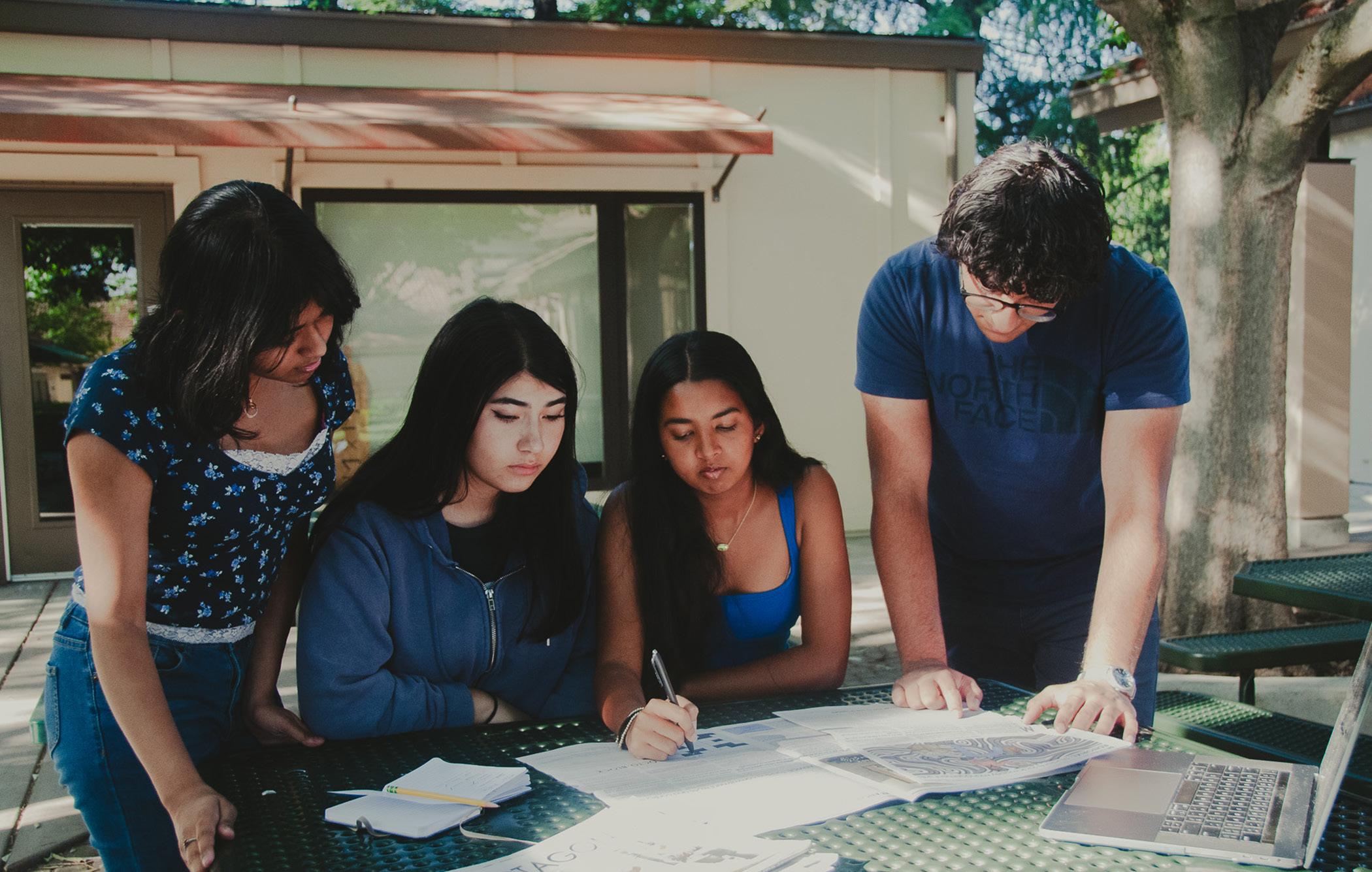
contributes to the quality of our publication,” Eberhart said. “Anisha is one of our strongest writers. Her page designs are always creative, and she reliably meets every deadline.”
Eberhart also acknowledged Afzal’s achievements and leadership capabilities.
“He’s an award-winning writer, photographer and a great leader with the kind of commanding presence we need from an EIC. He’s already showing that, and people definitely listen to him,” Eberhart said.
Nasirov is also looking forward to continuing as an EIC in the upcoming year.
“I’m optimistic for the future of The Octagon next year. I know that each of them have their own strengths to bring to the table, so I’m excited to work with them,” Nasirov said.
As a new EIC, Mondal expressed her appreciation for having Nasirov by her side and emphasized her goal of making the draft system more efficient and timely.
“When stories aren’t finished on time, it gets pretty stressful at paste-up,” Mondal said. “I believe that setting shorter deadlines for everyone could make it easier to stay on top of assigned articles.”
The Medallion strives to create the school’s yearbook by the end of each academic year. Juniors Claire Gemmell and Itzel Zamora will be replacing senior Manny Biddle as EICs in the 2025-2026 school year.
“Since her sophomore year, Claire has grown in confidence and creativity on the yearbook team. As design editor, she brings a fresh, whimsical slant, balancing strong ideas with a collaborative spirit,” said Melissa Strong, adviser of The Medallion.
Strong also looks for a balance between the EICs to maintain consistency while keeping the work enjoyable.
“Itzel brings a more serious, focused en-
ergy that really balances out Claire’s creativity. Together, I believe that they will keep the yearbook on track while still leaving plenty of room for fun and fresh ideas,” Strong said.
Zamora is thrilled and honored to serve the position next year.
“I would say I was happily surprised with the results,” Zamora said. “Next year, I plan to ensure that we’re more organized and deadlines are met. Designated roles like section editors have worked well and will definitely continue.”
Strong will be leaving The Medallion next year to focus on their master’s degree in her marketing program. Sarah Zaragoza-Smith, the middle and high school library assistant, will take Strong’s place as adviser.
“I’m sure Ms. Zaragoza-Smith is a great choice to take over The Medallion,” Strong said. “I hope she’ll continue to nurture the program. I think it’s in a really good place right now, and I’m completely confident that she will help it grow and thrive.”
Zaragoza-Smith understands the responsibilities that The Medallion brings. Having taken yearbook and journalism classes in high school, she is both excited and nervous to dive into this passion again.
“You’re creating something that’s not just temporary, but it’s this memento that you can hold on for decades to come,” she said. “I’m so excited to work with everyone and just watch their creativity blossom.”
Zaragoza-Smith hopes to provide basic support and allow students to take ownership of their publications.
“As the yearbook adviser, I see my role as providing a supportive framework — like a trellis — so that students can be the vines that can grow in any way they want on that trellis.”
BY NOOR ALAMERI
At the 2025 Spring National High School Journalism Convention (NHSJC) in Seattle, Sacramento Country Day School students from The Glass Knife, The Octagon and The Medallion attended sessions on topics ranging from AP style to interview techniques to page design.
The convention, in partnership with the Journalism Education Association (JEA) and the National Scholastic Press Association (NSPA), brought together students from various student publications across the country for three days of workshops, speakers, competitions and an awards ceremony.
Some of the workshops and presentations included “Reporting on Diverse Communities,” “Obtaining Press Freedom in Private Schools” and “The ABCs of L-IB-E-L.”
In addition to instructional sessions, the convention featured keynote speakers from national newsmakers including best-selling author Mónica Guzman, Amanda Little, an executive director at Kidizenship, a youth non-profit media
platform and various reporters and photo journalists for the Los Angeles Times, KING 5, Fox-13 News Seattle and The Seattle Times.
For Sarah Zaragoza-Smith, the convention served as preparation for her role as adviser to The Medallion next year.
“My primary focus was what can I learn from seasoned professionals who have been doing this for decades, who have won awards,” she said. “I think that the value for students is really dependent on what the student wants to get out of the experience.”
Ferishta Halim said that NHSJC was a bonding experience and a chance to learn from her classmates. “I don’t talk to a lot of people from Octagon, so when I was at JEA I learned a lot about what they do.”
NSPA holds a “Best of Show” competition for whole staff and individual students.
The Octagon placed eighth in the staff “Best of Show” competition.
JEA also holds both on site and online contests for high school yearbooks, literary magazines and newspapers.
No Sacramento Country Day students
were able to compete in the on site competitions due to registration issues. Going forward, Octagon advisor Andrea Todd, who judged the Editorial Writing competition, plans to enter students in the individual JEA competitions at next year’s convention in Minneapolis.
“For the contests that we sign up for, I want to work with the entrants and prepare them,” she said. “That’s one thing that the judging really does for me: it gives me specific information about what judges are looking for.”
Students also had the opportunity to explore Seattle, touring Pike’s Market, the Great Wheel and the Space Needle.
“I think that that was a really fun time, even though I have a fear of heights so I was scared,” Halim said.
The convention concluded with an awards ceremony that left an impression on freshman Parsiny Nijher.
“Just learning how many schools across the country care about that stuff and what we can do as a school to help our newspaper reach that level was really valuable,” Nijher said.
(continued from page 1)
For many families, the answer is increasingly unclear.
Reports of children missing school, parents too afraid to leave their homes and widespread confusion about the rights of school administrators that have been placed in schools, both public and private, at the center of the immigration debate.
Until recently, ICE avoided schools altogether. Under the Obama administration, a 2011 memo classified schools as well as hospitals and churches as “sensitive locations,” requiring high level approval for ICE operations on those locations. Arrests at or near campuses were rare.
In 2017, President Donald Trump issued executive orders that reversed many of those protections. While a Department of Homeland Security fact sheet at the time stated that the guidance “remains in effect,” legal analysts noted that the safe-zone protections had lost their force.
In response to the growing national concerns surrounding immigration enforcement, Sacramento Country Day has taken quiet but deliberate steps to prepare faculty for the unlikely event that ICE agents appear on campus. On March 26, Country Day staff received an email detailing protocol if ICE agents were to visit campus. The contents of this email were made available to and viewed by The Octagon.
The school’s move follows controversial declarations issued by then Acting Department of Homeland Security Secretary Benjamine Huffman on Jan. 20 permitting ICE to enter schools and churches. That change sparked conversations among heads of schools across California, including Country Day’s Head of School Lee Thomsen.
“We all started asking, ‘What do we do if this happens?’” Thomsen said. “So CAIS
[the California Association of Independent Schools] worked with a law firm that created a handbook for how to handle these situations. We took that and adapted it for our campus.”
In the email sent to Sacramento Country Day staff by Chief Financial Officer Bill Petchauer, teachers were instructed not to answer questions asked by agents and to bring any agents to the front office. From there, school administrators are tasked with verifying badge numbers of immigration agents and potential warrants. Additionally, administrators are responsible for contacting the school’s immigration attorney, which is provided through Vera & Vera PLC, a law firm based near Cal Expo.
School officials have stated that they will protect students to the best of their legal abilities.
“No one’s talking to kids without due process,” said Head of High School Brooke Wells.
The school’s protocol centers around a key legal distinction: not all warrants are the same. ICE agents may present two kinds of warrants — an administrative ICE warrant or a judicial warrant signed by a judge.
“If they only have an [administrative] ICE warrant, we are not legally obligated to comply,” Thomsen explained. “We would verify their identity and take badge numbers. Only a judicial warrant requires us to cooperate fully.”
Country Day has also instituted a protocol regarding a “privacy lockdown.” According to the email sent on March 26, students “would not need to hide in the classroom but rooms should be locked.” This protocol would be implemented if “there was a large presence of agents on campus.” Despite the creation of this protocol, such lockdown drills have not yet taken place at Country Day.
Although protocols have been established, the potentiality of a visit from ICE is described
as “unlikely” in the email.
Country Day chemistry teacher Victoria Conner, who has had prior experience with students being detained by law enforcement at other schools, said that interactions between students and law enforcement is a delicate matter.
“It’s always a sensitive issue when there are minors involved whose parents are not present. As teachers, we are seen legally as the parents of the students as long as they are within their classrooms,” Conner said. “It is up to us to make sure that the proper procedures are being observed by law enforcement or anyone else who needs to interview our students.”
Conner believes that a potential raid at Country Day is unlikely.
“It’s something I’m aware of as a potential issue, although I don’t feel like Country Day would be a top priority for ICE.”
Despite current political trends, the protocols implemented by Country Day are out of an abundance of caution, according to the email and interviews with school administrators. Additionally, Thomsen recognized the unprecedented nature of these events. “I’ve never experienced anything like this in my years at this school.”
“We don’t ask about student citizenship in the admissions process, so we have no way to know,” Thomsen said. “It’s just such a political thing right now that we decided to prepare quietly.”

Roundtable: Students weigh in on DEI, importance of staying informed
(continued from page 1)
Misquitta: I disagree with this decision outright. What I think he’s trying to get at here is the ED’s ability to control curriculums, but Trump misunderstands what the department does. It does not have absolute control over schools. School boards cannot disagree outright with the federal government, but they can choose to interpret laws in whatever way. So let’s say if Trump has an issue with the use of pronouns in a high school in the middle of Los Angeles. The school board has put that in place there. This is not the ED’s jurisdiction.
Reynen: One thing the ED does is assist students in need of federal financial aid. If you take that funding away, those people don’t get the same opportunity to learn. And for those people, it’s especially important for them to attain college education because learning is the path to success. A lot of times, these people don’t come from success, and they can grow into it. But by defunding these programs, you take that away.
Trump and McMahon don’t understand how the whole process works, and if they had done any amount of research, they would realize that their efforts are not in line with American policy and what we stand for, or how to actually achieve their goals.
Inman: I heavily disagree with Donald Trump. This order has a completely separate goal, a malicious goal, where if there is less regulation overall from ED’s for those edge cases, like young earth creationism [the idea that the earth was created by God within the last 6,000-10,000 years], for example, will be able to be accepted into schools’ curriculums. That isn’t accurate; it’s just not true. If the ED collapses, there is going to be no regulations guarding against those edge cases, edge cases referring to examples of people trying to teach belief and opinion instead of truth and actual information, like young earth creationism. School districts are going to have the ability to teach things that are just categorically false and I think that it’s a tool for propaganda and the manipulation of the American people.
Schroeder: Trump’s statement being that “controlling American education through federal programs and dollars has plainly failed our children and teachers,” is saying that federal management of education as a whole is bad,
which is genuinely wild to me. It’s wild because it implies that any problems within a jurisdiction can only be solved by that jurisdiction. That makes the statement one I inherently cannot understand the thought behind.
Q: In the same executive order, President Trump announced plans to defund diversity, equity and inclusion programs (DEI) in education; additionally, an earlier “Dear Colleague” letter sent by the United States Department of Education Office for Civil Rights renounced DEI programs on the basis that they are “smuggling racial stereotypes and explicit race-consciousness into everyday training, programming and discipline.”
Do you agree with this perception of DEI? Why or why not?
Reynen: I’m mixed in my opinion. I think that in terms of scholarships, it should be based on your economic background, granting scholarships to people who are economically disadvantaged. But the aspect of teaching DEI at school and in history classes and whatnot, it shouldn’t be required.
Inman: It goes to a greater issue on what exactly DEI is. Is the government removing informational things from the curriculum about famous pilots from World War II who were Black? Is the government removing information about genocides or about great catastrophes that America has caused as the result of post westward expansion? Is that considered DEI? Is information DEI?
That’s my fear. And I think that the weaponization of this term, especially in education, is very bad. It’s generally not going to have its benefits.
Schroeder: In response to the question “Is information DEI?” I think that the idea is that it’s more in the presentation of that information than necessarily the information itself. I think that when a fact is presented with an implied course of action, like “We need to do something about that fact,” it becomes “DEI” because it references making changes towards including and equalizing underprivileged or socially disadvantaged groups.
Misquitta: Bringing it back to scholarships: I agree with Isaac, and to expand on his point: the goal of these DEI scholarships, and there’s
one example of a Native American scholarship where you only get it if you’re Native American, is to bring underprivileged communities up, right? So if you make all scholarships more economically oriented instead of on the basis of race or sexuality, since a lot of these marginalized groups are often lower class or somewhere around there, it will bring up disproportionately more marginalized groups.
Q: Should students keep up with current changes to education in the U.S.? Why or why not?
Reynen: I think obviously it’s very practical to keep up with what’s going on.
Schroeder: For safety. Trans kids need to stay informed and aware of changes in education so that they can know what will bring them trouble. If tomorrow trans kids were being banned from being called their preferred name and banned from presenting as their gender, then that is must-know information. Not knowing what laws are being made about your existence can mean that you won’t hide your existence even when it brings you danger beyond what you might be willing to take.
Misquitta: I don’t know, if you’re like me
and you’re straight and you’re a dude, probably not. Overall, everyone should be aware, but the impact is different.
Schroeder: I think it’s good to keep up with changes to education, but I don’t know if you’re necessarily obligated to. It’s good to keep up with changes to curriculums, the general consensus on what should be taught and also what bills or executive orders directly will affect your learning experience.
Inman: I’ve had to go through so many issues with schools, CollegeBoard, districts, all these people regarding my autism, so I personally become very much in tune with what’s going on with changes in the US education system. I think it’s kind of closer to Griffin’s point, where I’ve had to have a lot of focus, but my sister’s had to have a lot less. It’s going to be pretty stable for a straight white dude, but it’s not going to be nearly stable for a trans woman or someone with autism.
Reynen: I think there are an absolutely enormous number of things that are extraordinarily important affecting the entire United States. You have to be aware, and if you want more power in making a change, you have to know what you’re changing.
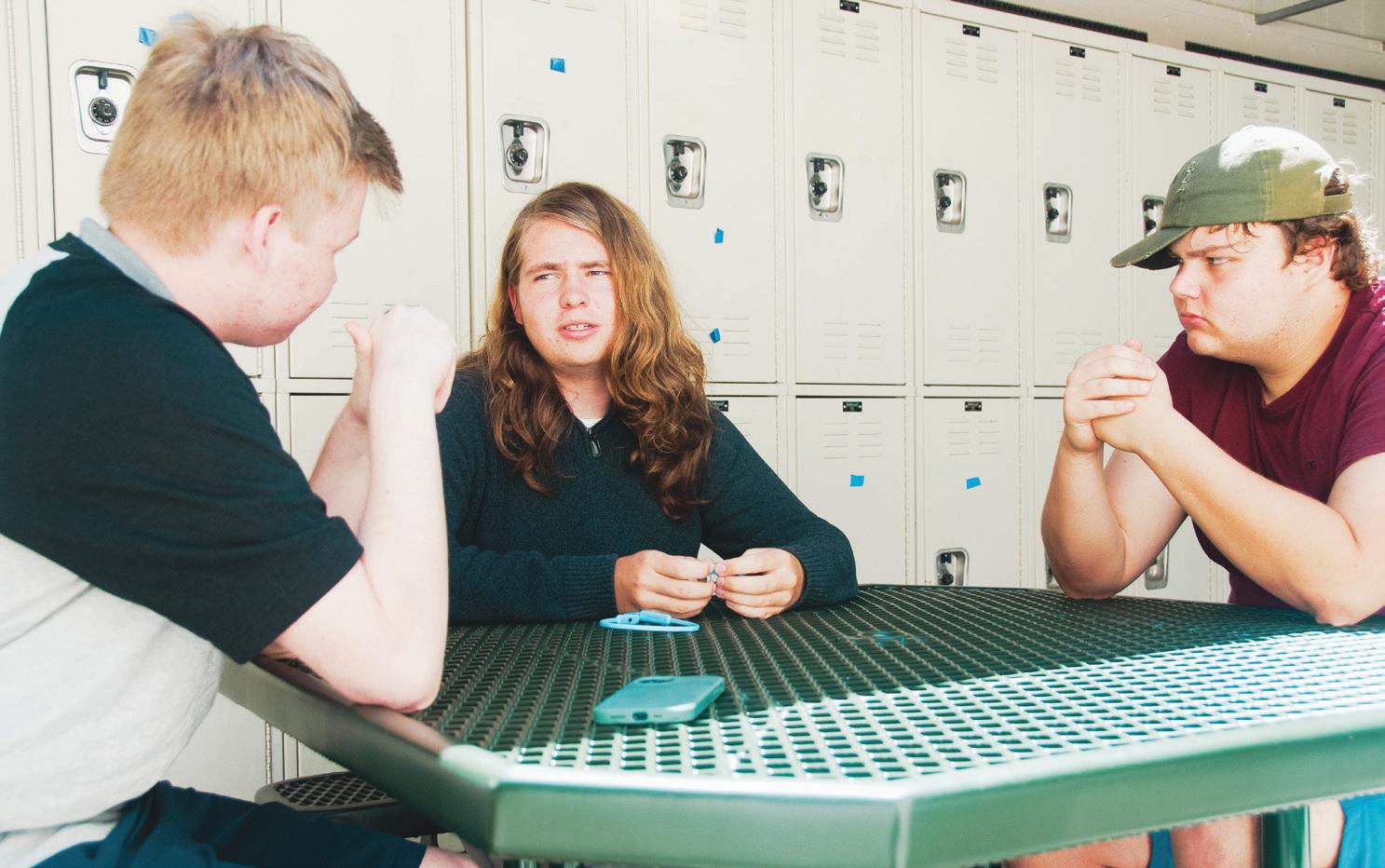



In the darkness of a stage, a voice emerges, singing. A hush falls over the audience as the song rises. The searching spotlight finds its star: Harriet Agyeman.
Agyeman is currently a freshman at Sacramento Country Day and has performed in multiple theatrical productions, including “The Emperor and His New Clothes,” where she played Harold and Lady Winifred, and the “Sister Act: The Musical,” where she played Deloris Van Cartier.
Her theater career began as a sixth grader at the Natomas Charter School’s Performing Arts Academy. After signing up for what she thought was a production class but was actually a musical theater class, she was transformed by the world of musical theater.
Agyeman ended up staying for the entire year, performing her first show — “The Emperor and His New Clothes” — during the summer before seventh grade.
Her dream has always been to become a pop singer or actress, but Agyeman realized that musical theater combines these two loves.
“Musical theater allows me to put myself into a different character’s shoes and perform so that other people can feel the feelings of the characters, exactly how the writers wrote it,” Agyeman said.
During the summer before eighth grade, Agyeman attended New York City’s iTheatrics program.
Through the program, she was able to create her own musical, alongside other musical theater composers and producers — one of which was Rob Rokicki, the American writer and composer best known for “The Lightning Thief: The Percy Jackson Musical.” She choreographed performances and wrote the story and songs that resulted in her musical, which will become licensed soon. She signed a non-disclosure agreement with the program to not release the name of the musical, but
she gave a few details as to what it is about.
“It’s kind of like the ‘Zombies’ movie, with werewolves and characters like that. It’s about a boy who’s a ghost, who is considered not a part of the real world, so he feels very left out. But in the end, he finds people that accept him,” Agyeman said.
Agyeman credits this program with igniting her ambition.
“After finding my voice, I realized that drama is something that I truly want to pursue, because I feel like I can’t live without it. Theater is engraved into my body, everytime I think, everything I work for is to become a better version of myself in musical theater” Agyeman said.
Agyeman is currently part of the Master Academy program — a training program under Master Mayhem Productions — where aspiring musical theater talents practice to perform and audition for a spot on the Broadway stage.
She trains for three and a half hours a day per week at the program, starting at 5:30 p.m. and ending at around 9 p.m.
What little free time she has is spent completing school assignments and studying for tests. During many of her trips to drama practice, she often has to complete her homework in the car.
“I have a goal and I have a dream, but school also matters, so I make sure to make time for both of them so that I can be great in both ways,” Agyeman said.
Out of all the productions she has been a part of “Sister Act: The Musical” has been her favorite, due to the message of the play, the vocals and music it encompasses.
“In the musical, every character matters. It talks about hope, becoming who you are, realizing your true self, and that people shouldn’t hold you back because of who you are,” Agyeman said.
Before landing the prominent lead role of
Van Cartier in “Sister Act: The Musical,” Agyeman had to rehearse for 5 months — from March to July — perfecting her acting and singing skills to truly bring out the character at the audition.
According to Agyeman, Deloris Van Cartier is hard to portray due to being a character that showcases a bubbly and demanding presence on the outside, despite being insecure on the inside. Agyeman had to take time to practice and figure out how she could portray this internal conflict before her audition.
The role also calls for powerful and intense vocals, which took some time for Agyeman to perfect.
“The hard work that I put into it, the effort it took to get this role and just the thought of the acting and becoming this new person, everything was just an amazing experience — and it all paid off in the end,” Agyeman said.
Before going on stage, Agyeman makes sure to stay quiet both in a literal way, by not talking, and in a mental way, by making sure to clear her mind of anything unrelated to theater before performing. To prepare for the dancing aspect, she stretches to ensure that her body is warmed up enough before the performance.
In personal backstage meditations, she thinks about how she can portray the character, what her goal is, why she is there, and what her purpose is for the whole production, and for the audience.
“It’s live theater, so of course mistakes will happen. I try to accept that and realize that even though I’m not gonna be perfect, I’m just here to tell a story and for people to have fun and laugh and enjoy themselves,” Agyeman said.
For Agyeman, musical theater has not only inspired her future goals but has also helped shape her as a person. Being unconfident with her musical theater voice when she started in sixth grade, and evolving into the voice she
currently has now has helped her realize the amount of new confidence that musical theater has given her.
“I worked so hard, and people compliment and reward me for it. It’s like I am reaping the fruit of my own labor. So my growth is really what shaped and increased the confidence I have now as an individual,” Agyeman said.
Agyeman hopes to star in a Broadway production as the ensemble or as the main character — specifically as Betty Boop from “Boop! The Musical.”
Once she advances in another program that she is in — Broadway Dreams — Agyeman will have the chance to audition at Radio City Music Hall in New York City, the venue where the Tonys are held.
In front of multiple casting agents and directors, Agyeman would have an opportunity to secure a spot in the ensemble — or possibly with a lead role — on Broadway.
“Without an ensemble, there wouldn’t be any point in having a lead character, as they support the whole production. In musical theater, sometimes the ensemble plays a more exciting role. But, if the opportunity to play Betty Boop arises in the future, I would definitely take it,” Agyeman said.
Offstage, Agyeman hopes to double major in both biology and theater in college. She is currently looking for colleges that have both a strong theater program and a strong, well-funded science program.
Agyeman enjoys listening to hip-hop music while exercising to destress. Some rap artists that she enjoys listening to include Drake, Kendrick Lamar and GloRilla.
For aspiring musical theater talents who are scared to fully dive into musical theater, Agyeman recommends to just go for it, to see how you feel.
“If you don’t like it, you don’t have to do it again. Just take a leap of faith,” Agyeman said.
In seventh-grade pre-algebra teacher Laura Steele Monahan’s classes, math is never boring. From playing on a probability carnival to designing Pet Palaces on Desmos and even learning different types of slopes by dancing, Monahan strives to help kids see math as she does, “a beautiful, interactive set of patterns.”
Now, after three decades of teaching at Sacramento Country Day Monahan is preparing to leave teaching and move to Spain for cultural exploration.
Monahan originally started teaching at Country Day as a long-term substitute teacher, then for seven years taught fifth-grade math, science and history. She was the director of Summer Bridge Sacramento (now called Breakthrough Sacramento) from 2002 to 2005. Break-
through Sacramento is a six-year college preparatory program for kids in under-resourced neighborhoods.
“These kids are likely to become first-generation college students,” said Monahan.
“It had a second mission of increasing diversity in the teacher pipeline by hiring talented college students and sometimes high school students to be their teachers and mentors in the summer,” Monahan said.
For fund-raising purposes, the program became its own nonprofit in 2017 with a different fiscal sponsor, Community Initiatives. Monahan has been on the advi sory board of Breakthrough Sacramento ever since.
“I’m still really involved in it, and I have really good friends who were students and teachers [of Breakthrough Sacramento] at the time,” Monahan said.
Monahan was also one of the teachers who helped establish Coun try Day relationships with Rulindo schools in Rwan da. Monahan has played the flute in the Annual Gerlinde Klauser Play-a-thon for Rul indo.

mr. bolman
After 25 years of teaching that started in a Korean Dojang and ended up here at Sacramento Country Day, sixth-grade math and history teacher Edward Bolman has announced he is leaving — for a move to Kentucky.
Bolman’s teaching career started in a Dojang (a formal training hall for martial arts) when he was in middle school, where he had previously studied since he was seven.
Bolman later moved to Guangdong Province in 1999 to teach in the Chinese public school system, marking the first years of his official teaching career.
“One of the first things you realize once working as a teacher is that all of the theory you learn changes once you get into the real classroom,” Bolman said.
Although Bolman faced a language barrier — being unable to speak Chinese and teaching students with limited English skills — Bolman believes that his early teaching experiences in China shaped a big part of how he teaches now at Country Day.
“We were using a curriculum, and we had games in those classrooms,” Bolman said.
“When people ask about my highlights and favorite moments at Country Day, I always like to say that I love to play the flute with the band at the Rulindo Play-a-thon,” Monahan said.
tations, plenty of love, and lots of understanding when things go wrong — is really special to me,” Monahan said.
Though seventh grade wasn’t specifically miserable for Monahan, she notes that middle school is generally difficult due to puberty-related issues and finding a sense of belonging.
Monahan wanted to teach math in order to present the subject as both interactive and “conversational,” exploring the concepts rather than simply memorizing them.

For the past 20, Monahan taught seventh-grade pre-algebra and algebra, occasionally teaching eighth-grade geometry class.
Throughout her years, Monahan enjoyed watching her students grow, from navigating middle school to preparing for college.
“The way they are processing through life and figuring out how to balance school, hobbies, and social issues, I just love that,” Monahan said.
Monahan especially understands the struggles students face in seventh grade — a year that Monahan remembers as difficult for herself.
“Anything I can do to help get kids through seventh grade — with high expec-
One thing Bolman does differently from most teachers is incorporating these games into teaching.
“A lot of times you just have ‘Drill it and Kill it’ kind of math — just go over and over and over, and that’s how you learn how to master math, right?” Bolman said. “But when you’re talking to students coming into middle school, you have to sell the idea of having fun with something and learning about it.
To “sell” the idea of learning to his students, Bolman hosts basketball games using a mini-hoop in his classroom.
Bolman explains the rea son for hosting this games as making class more entertaining.
“Honest ly, think about it: If you’re a teacher, and you get bored teaching the same classes every day, you’re not going to teach your best.”
“I loved a lot of my math teachers, but it was a lot of, ‘Hey, you’re going to practice this skill, and then we’re going to move on to the next one,’” Monahan said. “So I’ve always tried to find ways to say, ‘How can I help you get that sense of why math is this beautiful, interactive set of patterns?’”
One of these ways was “Polyhedraville,” a handson project held annually during her time teaching fifth-grade.
“The kids would make paper geometric figures and figure out their surface areas and volumes,” Monahan said. “We laid them out, and they were amazing on the wall.”
Monahan strongly believes in keeping the doors of mathematics open for all students.
“I would like to make sure as many kids see themselves as mathematically competent as possible,” she said, adding that she hopes students won’t avoid advanced math or science in high school due to self-doubt.
As she prepares to start a new chapter in Spain, Monahan leaves her students with a powerful message that challenges a common misconception about math.
“There is no such thing as a math person,” Monahan said. “You are a person, so you can do math — it just takes practice and determination.”
STORY BY JACOB RABE; GRAPHICS BY SID SHUKLA & ZACHARY VANDO-MILBERGER; PHOTO COURTESY OF REHAN AFZAL
Every year, near the end of the third quarter (late March), Bolman hosts a full-day Greek Olympics exclusively for sixth-graders to mark the culmination of their studies on ancient Greece in his history class.
Bolman started this tradition in his very first year with Joel Rickert, a former Country Day middle school English and History teacher who now teaches inmates at Folsom Prison.

Seventh-grade English teacher Kathryn LaComb remembers how her children (who had Bolman as a teacher) would frequently talk about these games at the dinner table.

He found that the games built into the curriculum were easily accessible, thus inspiring him to use similar methods in his teaching at Country Day.
“They did tomb-raiding, and I think my son died by falling into a head of poison darts,” LaComb said. “There was always something creative and just entertaining.”
Outside of hosting basketball to help students practice math, Bolman plans to host a game centered around gladiators, where students pick a gladiator style and make game cards.
“The winner will get their own little wooden sword that I’ve made and painted with their name on it, the same way you did if you won your freedom in Colosseum combat,” Bolman said.
“[Rickert] said, ‘Hey, I have this idea. Want to do the Greek Olympics?’ And so we started that out together,” Bolman said.
Bolman has maintained the tradition since, growing it by incorporating javelin, discus-throwing, a race wearing armor and other events. However, he’s unsure if the teacher who takes his position will continue the tradiBolman plans to move to south central Kentucky and teach there after finishing his term at Country Day. He plans to search in earnest once he is there, since many jobs he saw required immediate start dates that would have forced him to leave mid-
His reasons for leaving the West Coast include the costs of retirement, a desire to downsize and a craving for rural life and a slower pace.
“My wife and I have always wanted to retire to a rural area,” Bolman said. “It’s not going to be very easy to retire in California for a lot of people, ourselves included, and we didn’t want to stay in our house in California as our forever home.”
Though Bolman currently lives in a two-story home, he wants a one-story home as he gets older.
“The pace of life in Kentucky is also slower,” Bolman said. “Our house is on a one and a half acre farm basically, but we’re gonna have a chicken coop and maybe some small animals and things like that.”
Bolman will ultimately be 30 minutes from the nearest town where he lives in Auburn, Kentucky — a life he prefers over Rancho Cordova.
“Where we will live only has 1600 people, and the nearest town is Bowling Green,” Bolman said. “That’s where they make Corvettes, actually.”
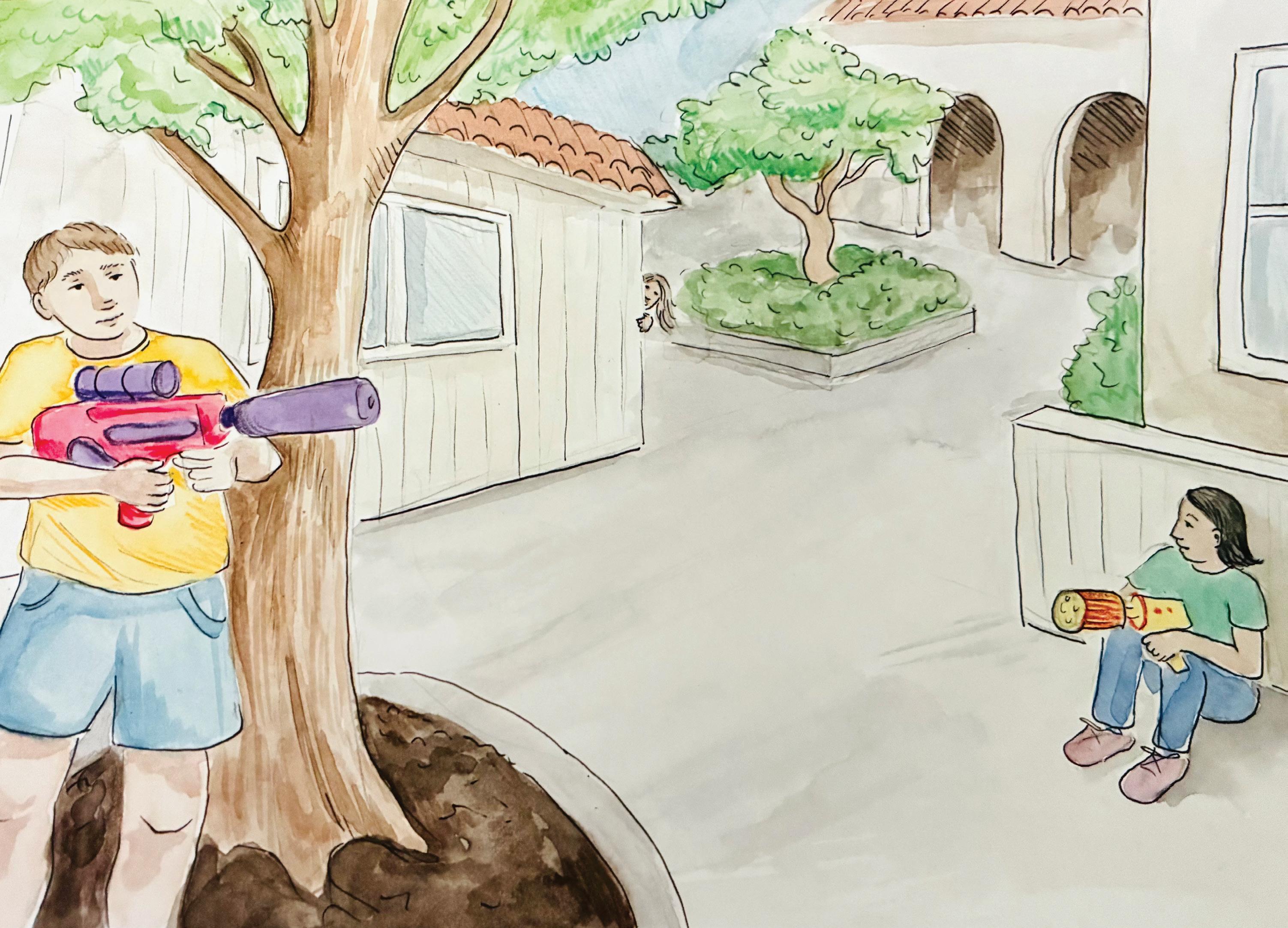
Nerf Night was a beloved middle school tradition which faced its untimely demise due to the COVID-19 pandemic. In 2023, then junior Kasmer Conner attempted to bring back the tradition and introduce it to Sacramento Country Day High School.
On April 14, 2023, Nerf Night was supposed to be held from 7-9 p.m. Unfortunately, the event was cancelled the day before, upsetting the student body. A poll sent out to the student body on the day of the cancellation indicated that 83% of the 54 respondents originally wanted to attend the event.
Bringing back Nerf Night — a two hour after-school event where students enjoy a night of fun with Nerf blasters — would boost morale and bring the student body closer together, despite reasonable concerns raised by some.
At the time of the event’s cancellation in 2023, teachers and students voiced concerns regarding the presence of toy blasters on campus, which could have possibly been construed as firearms.
However, in the 2024-2025 school year, Country Day permitted water blasters on campus as part of a “senior assassin” event, where students try to ‘knock out’ other students by spraying them with water, until only one person remains.
The brightly-colored toys used in this event bear no real resemblance to actual weapons, and cannot be easily misconstrued as such, even by a passing observer. Foam Nerf blasters are no different.
In fact, the Super Soaker brand — likely the most well-known water blaster name in the United
States — is owned by Nerf. Furthermore, the use of water blasters on campus has spread beyond the graduating class, with lower grades using them on the back field.
Admittedly, the fun got a little out of hand. The current High School Dean of Student Life, Patricia Jacobsen, sent an email temporarily banning their use on campus on May 16, with the ban being lifted on May 20 due to good behavior from the student body. “Usage will be limited to the back field area, as long as that area is not being used by another group,” according to the email.
This begs the question: Why are water blasters allowed during school hours, but an organized after-school event with Nerf blasters is banned?
For a school event, foam Nerf blasters have inherent advantages over their liquid counterparts. A Nerf night could be held in any season, whilst a water skirmish could really only be held in summer, unless students are content with wearing sopping wet clothes in the middle of a damp Sacramento winter.
If the school has concerns that passersby viewing the Nerf blasters as actual firearms, a ban on modified toys could be enacted.
Aftermarket attachments or painted blasters, which could be mistaken for actual weapons, could be prevented in policies, which could be enacted easily. If needed, higher velocity Nerf blasters, such as those from the Rival series which shoot foam balls instead of foam darts, could also be prohibited.
Nerf blasters, which shoot non-expanding foam darts, are neither dangerous nor promote violence
in any way. They do not normalize acts of violence committed with firearms, nor do they entice students to commit similar acts. Studies show that such correlations do not exist.
Researchers at Stetson University concluded that the relationship between weapon play and juvenile criminality was “small and not significant.”
If concerns regarding the presence of toy weapons on campus exist, water blasters should face the same ban. In essence, a contradiction is created: toys intended to shoot water are banned, yet their visually identical foam equals are prohibited. Should people still feel uncomfortable on campus, Nerf Night could be held at another location, such as in Ancil Hoffman Park.
However, this should not be the default solution. The temporary ban on water blasters this May was lifted just four days later after students proved they could be trusted. If trust can be extended in that case, why not here?
The last class that participated in Nerf Night is the current senior class. With their current graduation, this small but meaningful Country Day tradition will be lost to time.
Such events are essential to Country Day’s culture. We have our differences. Not everyone is a humanities student. Not everyone is a science student. But we can all participate in Nerf Night and enjoy a night of fun.
The use of water blasters at school has already demonstrated that students have enough responsibility to use such toys responsibly, and has only made the student body stronger as a whole. Perhaps it is time to allow their foam analogues.
BY JACK ROBINSON & ZACHARY VANDO-MILBERGER
While changing for his Sacramento Country Day physical education class, a kid is mocked for his “farmer’s tan,” making him feel stupid and embarrassed. Though he otherwise loved physical education class, this experience is one he still remembers years later.
A certain Octagon moderator vividly remembers being called “Dolly Parton” by the boys in her eighth grade class while running her assigned laps for physical education class (not at Country Day). She did not run again until age 27.
The Los Angeles Times reported a story about parents suing the Laguna Beach School District because a physical education teacher mocked their son, 14, for being overweight, “forcing” him to take part in activities despite chronic headaches, a broken ankle and a doctor’s note excusing him from the activity. The suit cited discrimination, civil rights violations and emotional distress.
The worst time for a student to be shamed, at the peak and in the midst of puberty, is exactly when students are forced to participate in a non-inclusive, toxic class that can scar them for life. Physical education in California doesn’t always encourage students to do physical activity — it can, and too often does, turn them away from it for life.
Requiring students to complete requirements that could take away from the activities they enjoy can create lifelong negative associations with physical activity.
Students reporting significant “negative experiences” in physical education have been studied and proven.
A 2013 Oregon State University study regarding the overall aspect of physical education published reports of bullying.
One student was quoted as saying, “[physical education] robbed me of the joy of physical activity for many years. It destroyed my physical confidence.”
The participants remember negative emotional reactions to the memories of physical education classes — reactions that have made them reluctant to participate in physical activity for years following their physical education classes.
Another student said, “To this day, I feel totally inadequate … and have a natural reflex to avoid [physical activities] at all costs … largely because of humiliating experiences in childhood.”
According to the study, 34% of students who had negative physical education experiences attributed it to embarrassment alone.
Negative physical education experiences have “some degree of influence on the degree of [adults’] sedentariness,” accord-

“Bruises You Can’t See” by Claire Gemmell
ing to a journal published by the American College of Sports Medicine.
This perfectly illustrates just how counterproductive physical education can be — driving students away from physical activity, which is the exact opposite goal of physical education.
According to the Centers for Disease Control (CDC) physical education is “a planned, sequential K-12 program … is designed to develop motor skills, knowledge and behaviors for physical activity and physical fitness.”
But physical education falls far short of this goal. Instead of developing knowledge and behaviors, it encourages students to be competitive and embarrasses students who are not.
So the question remains: how can the education system protect students from this horrible experience while still keeping the fundamental aspects of physical education?
California could implement an independent physical education system like the one Country Day has in place, which
is flawed but not dysfunctional. This would allow students to complete their physical education on their own, away from any embarrassment or bad experiences they might have.
Country Day’s system allows students to play sports outside of school to complete their requirements. This could help students avoid humiliating experiences and be in an environment they feel more comfortable in. However, it still forces students to play a competitive sport or work with a personal trainer, which are significant time commitments, so the policy needs more flexibility.
For example, for a student with extracurricular activities that take up a lot of time, the physical activity in question could be something as simple as yoga.
In fact, the California requirement allows activities such as golf, which doesn’t consist of intense and consistent heart-pumping activity — compared to basketball or flag football — so adding an activity that doesn’t require a large time commitment and that a student could do
BY ANONYMOUS
This advice column responds to questions shared by Sacramento Country Day students anonymously. To submit, send a question to the Google Form sent out on May 8. Responses are not guaranteed, but all submissions are welcome.
Q: I’m a senior in a serious relationship. We will be going to different colleges next year, so we’ll have to be a long-distance couple. Is it even worth it?
You’re on the brink of one of the most pivotal transitions in your life: leaving high school and stepping into college. With the additional weight of navigating your current romantic relationship, I feel for you. You are not alone in this situation — it is not uncommon for students to date throughout high school and suddenly reach the roadblock of diverging college paths.
But to be completely honest, there is no one-size-fits-all solution.
Some couples adapt well to the sudden distance between them, while others naturally drift apart. Remember that as you step into this new chapter of your life, you will both inevitably evolve into new versions of yourself — sometimes in a similar direction, sometimes not.
So have an honest talk with your partner — are both of you willing to put in the work to stay connected while still growing as individuals?
Assuming both of your answers are yes, know that this will be no easy feat. A long-distance relationship requires real effort: consistent communication, clear boundaries and deep trust in each other.
But people do make it work. With today’s technology, long-distance relationships have become more manageable. Use FaceTime to your advantage by scheduling calls as often as possible. Send your partner quick text updates throughout the day. Reassure them that despite the hundreds
of miles between you, they’re still a part of your life.
That said, don’t feel too bad if it doesn’t work out. No matter how much effort you put in, distance can still take a toll — emotionally, mentally and even academically. Neither of you should feel ashamed to let go if the relationship starts to feel more like a weight than a source of support.
Sometimes, the healthiest choice is to part ways with gratitude for the beautiful memories the relationship gave you. And remind them — and yourself — that they were never the problem; life simply pulled you in different directions, and that’s OK. Whatever happens, know that your connection is — or was — real and meaningful. While I do genuinely hope that you and your partner will remain together forever (and that’s totally possible!), forever isn’t the only measure of a successful relationship. If your time together brought you joy, helped you grow and taught you how to love, then it was all worth it in the end.
at home to the list would not be difficult. These would be activities that could allow students to still participate in their own extracurriculars while completing their graduation requirements.
Another solution would be for parents to sign a document exempting their student from the physical education requirement. An application form could allow students who need this accommodation for personal reasons to take advantage of it, but cut down the number of students using it as a way to get out of the class.
Physical education in California has issues, but they can be solved with some simple solutions — using Country Day’s own program as a foundation.





17 willattendcollegeout ofstate
























On any given spring day, butterflies, birds and honeybees flutter busily about the vibrant flowers in Sacramento Country Day’s school garden. Laughter rings out from lower schoolers tending to the rows, middle schoolers harvesting fresh food, high schoolers relaxing on picnic blankets and staff gathering newly-picked vegetables to take home.
The garden started in 2005 after the school’s Frank Science Center was built. The space that was previously a construction zone for the building became available for use. The school decided to turn it into a school garden or farm.
Former high school chemistry teacher Michael Covey proposed the role of a garden coordinator, a role he would later take on. Drawing on his experiences working with Soil Born Farms in Rancho Cordova, Calif., he played a heavy part in providing the foundation for what the space is today.
Initially, the garden was used primarily as a middle school space. Middle schoolers were required to drop various classes, such as physical education, once every schedule rotation to work on the farm. Because not all students were interested in farm work, the activity was shifted into the elective program.
Over time, input from students built the elective into Farm to Fork, an elective that teaches farming, cooking and budgeting for buying extra supplies, concluding with a cook-off at the end of each quarter.
Today, Rory Tira is Country Day’s Garden Supervisor.
Prior to the COVID-19 pandemic, Tira had some experience with backyard gardening, but after volunteering to work at an urban farm, she developed a love for farming and the community surrounding it. Tira discovered her current job while searching for one that would allow her to combine her 16 years of teaching experience with her love of farming.
Then, one day, a friend texted her: Coun-
try Day was looking for a garden coordinator.
“I was like, are you serious?” Tira said.
One of her first goals was to get more people in the garden. She attached watering cans to the fence by the sink, now known as “The Watering Can Wall.” She describes the feature as “an invitation.”
Seventh-grade science teacher Aleitha Burns often utilizes the garden for her classes, which center around making qualitative and quantitative observations about the world. In addition to science, Burns teaches and runs the school’s Farm to Fork elective, also taught there.
“Having an outdoor space and having a teachable moment where a bluebird lands, or when you see a bird eating an insect, or you see a dragonfly come down and eat another dragonfly, that to me is bringing science to life,” Burns said.
This aspect of teaching — through interactions with the natural world — also carries over to lower school students, who harvest tomatoes, peas and strawberries.
Seeing where the food comes from and gathering it themselves is more enjoyable for the kids, according to Tira.
“A lot of young kids think they don’t like tomatoes, but then when they taste good tomatoes, they’re like, ‘Oh, I didn’t know it was like this.’ The minute you take that food inside, they’re not going to eat as much. It’s just not as fun,” Tira said.
Tira also added a play area for Pre-K and Kindergarten, and picnic blankets for people to relax on. She wanted to make a space for classes to be held outside. When the redwood trees on the back field were cut down, she used the wood to create a stump circle for that purpose.
But it wasn’t just classes she was focused on. Tira wanted to make sure that the garden was a campus workspace — a place where students of all ages could go to get work done, especially because of the atmosphere the garden provides.
“It’s not an unplugged garden, but it
adds a layer of that. Even if you’re on your screen, you’re still out here,” Tira said. “I think nature and the green space give a lot too, for mental health.”
Junior Jackson Whited, who volunteers in the garden, agrees.
“It is a great area to connect with nature and to spend a little time outside. I also think that it is a perfect place to relax, whether that be doing homework or spending time with your friends,” Whited said.
To Tira, the community is one of the most important functions of the garden.
“You can have Pre-K out here, or kinder gartners, and then high schoolers are sitting at a table working on a project, and then eighth graders might be working in the rows. It’s one of the only physical places on campus where the grades intermix,” she said.
Another key focus of the gar den, for Tira, is to be an enjoyable space.
ing care of the plants and various building projects, something that Whited enjoys.
“Volunteering in the garden is an awesome experience,” Whited said. “I honestly wish I could get out and volunteer more during the year, but I don’t have as much time to do this as I’d want to.”
Climate change has made maintaining the garden difficult; however, especially during the summer.

“Longer, hotter summers and our springs getting shorter and warmer has made it really challenging to grow some of our seasonal foods,” Burns said.

“A garden should be fun and not so serious, and there should be little surprises. Some of the surprises are for the six-yearolds, and some of them are like, you’re 16, and you’re like, ‘Oh, that’s kind of cool,’” Tira said.
She takes inspiration from Fairytale Town (an amusement park in Sacramento, Calif.), thrift stores and plant nurseries for some of these surprises. This philosophy has led to many fun decorations and features scattered throughout the garden and between the rows, such as the three recently added book boxes that she calls Little Libraries.
“She is an artist out there,” Burns said. “You’ve probably noticed there’s lots of interesting, little, unique spaces that she started building for kids just by watching how people interact with the space.”
The garden offers an opportunity for high school students to get their community service hours during the summer by tak-
Last summer, the garden suffered from extreme heat, with multiple days having temperatures over 110 degrees Fahrenheit.
“A garden in the summer should be thriving and booming. Last summer, all I kept thinking was ‘keep it alive,’” Tira said.
If high temperatures in the summer become the new normal, the garden may need to swap to native plants, which are able to withstand the droughts and harsh conditions. While this could attract more wildlife, having no watermelon, tomatoes and not as many flowers to cut would turn the garden into more of an educational habitat than a productive farm space.
So next time you walk past the garden, stop and appreciate the diversity of plants and the relaxing ambience it offers. Maybe cut some flowers, grab some strawberries or offer to help out. As Tira put it, “spending time outdoors — We’re only going to be better from it.”
BY PARSINY NIJHER
In its second season as a newly-organized school team, Sacramento Country Day boys volleyball team placed sixth of 24 teams in the CIF (California Interscholastic Federation) Sac-Joaquin Section Division 5, finishing their season with an overall record of 11-7.
Coached by Jason Kreps, Country Day’s physical education department chair, Cavs boys volleyball ended their 2025 spring season with a trip to the CIF Sac-Joaquin section playoffs, despite being a relatively new team.
Last year, in the spring of 2024, the Country Day Boys’ Volleyball team started its first official season. However, the process took years of effort and discussion.
Junior team co-captain Gavin Wang remembers the process dating back to his middle school years. As an eighth grader at Country Day, Wang discussed possible options for a team with the physical education department.
“My freshman year, we had a club table during open house, and talked to Coach Vargo and Coach Kreps,” Wang said.
Kreps noticed that Wang’s persistence for the team was a factor which aided the team’s overall establishment.
“The problem was that we have a very small high school, and there’s a lot of spring sports. The biggest issue for Mr. Vargo was not being spread thin and taking players away from other sports we have,” Kreps said. “But I think it’s worked out well, but that was kind of a hesitation in the beginning before it all came together.”
However, Kreps wants to push for more players to eventually have both a junior varsity team and a varsity team. Kreps thinks that having a JV team helps the development of incoming players, especially those new to volleyball.
“It would be nice to have a second team so that you’re developing players, because playing varsity, there’s times where I need to put people in, but I don’t want them to get hurt,” Kreps said.
Wang’s overall goal is to have a long-stand-
ing program established, and believes recruiting and encouraging boys to join is the way to do so.
“People should try to play volleyball, even if it’s out of their comfort zone, especially for
team you see in league competitions.
“A typical team has the majority of their experienced players as seniors or juniors. This year, there were only two seniors and the rest were juniors, sophomores, and freshmen. So instead of having a senior captain, the two

more boys to join the year after,” Wang said. Last year, boys volleyball had 17 players. This year, the team had 10. Both upperclassmen and underclassmen played together, which according to senior Cara Shin, assistant coach of the team, is different from the typical
sult of people graduating or transferring out. But Wang believes the team is still in a very good place.
This year, the team’s mix of upperclassmen and underclassmen led to the team’s first playoff appearance. Shin believes that the team’s relationship with one another affected
their ability to make a run to the playoffs, and their success throughout the entire season.
“Everyone is on an equal playing field where most people feel free to give each other pointers or suggestions,” Shin said.
Kreps believes that the whole team is “very cohesive” and works well together, which is an aspect to a successful team.
“To me, it’s about growing as a team and getting better. Success, for me, is just developing relationships that you might not have had,” Kreps said.
Additionally, Wang has noticed an improvement in performance among players of the team, and an increasing level of experience. This experience has also been credited to the team’s success.
“We’ve improved a lot since last year. I want to say about half of our people have played club seasons over the summer and during the school year this year, which has been very helpful,” Wang said.
Shin believes that the extra time and practice spent in the off-season affects how a team performs during the season.
“It’s necessary to build strong fundamentals in volleyball during the off-season. I think the practice has given them the reps and competition during the off-season that they needed,” Shin said.
Kreps encourages anyone thinking of joining to get extra practice outside of school and to try out for the team. Shin said that the overall environment of the team is welcoming to new players who are willing to put in the time.
“As long as someone is committed, they don’t necessarily have to be a star player to be accepted. Coach Kreps is always interested in possible freshmen who can build their skills as the years progress,” Shin said.
Although the team lost the first game of their playoff series, 3-1, Kreps believes that they can create another successful season.
“I’ve been around the game a lot, so I kind of know the nuances to different things, and I know what makes a successful team. This team has taken that on, so that was helpful, just having the experience,” Kreps said.
BY LUKAS CHUNG
“It’s not about the journey. It’s about the destination,” sophomore Niam Patel said.
In Niam’s recap of the game, this is how he describes hitting three shots into trees at the very first hole of his round.
The destination in question is the boys golf team winning first place and the Sacramento Metropolitan Athletic League (SMAL) golf championship title. The tournament, held on April 28 at Haggin Oaks Golf Complex, determined league placements, and included six participating schools: Western Sierra Collegiate Academy, Sacramento Adventist Academy, Valley Christian Academy, Faith Christian High School, Cristo Rey High School and Sacramento Country Day.
The golf team’s coach, Kristoffer Hall, highlighted players that stood out the most.
“Our top three, pretty consistently all season, have been Kale Patel, Henry Wilson and Niam Patel. Those are the only three golfers that have played in all four of our league matches,” Hall said.
Brothers Niam and junior Kale have six years of experience, and usually practice together during the summer. While the Patel brothers are ex-
perienced, this is senior Henry Wilson’s first year playing competitive golf; before joining the team, Wilson had only played casual rounds with his friends. While these three players were consistently the most standout on the team, their nervousness affected all of their gameplay during that tournament.
Wilson felt the anxiety of playing in a high-stakes tournament for the first time.
“On the first tee box, I think my heart rate was like 150 standing over the first drive,” said Wilson.
Despite the pressure Wilson felt, he overcame his nerves.
“I was able to score when I needed to; and I even got a birdie on hole 16, which was really big for my score,” Wilson said.
Despite the tense state of the match, Wilson narrowly reached his goal of scoring under 90 points, by getting 89 points. This was Wilson’s first season.
Niam also felt this pressure once he started the round.
“I was feeling really confident. I was hitting my clubs really well before the game, but the first front nine, you have all that pressure, and I was feeling pretty nervous,” Niam said. Due to the
pressure he felt, Niam did not start the round strong.
“The first hole was what really screwed me up. I hooked one into the tree, and then I hit another tree and then got it in another. So, like the entire hole, I stayed inside the trees,” Niam said.
As the match continued, he felt less anxious. On hole 18, he made a recovery that saved his score.
“I hit my driver straight down the fairway, it was an amazing shot. Then I hook my seven iron into a tree, and I lose it. Then I take a drop, and I hit it right onto the green, where I get a one putt,” he said.
Although Niam didn’t start off the round how he wanted to, he brought back his score and played well throughout the round.
Kale felt like he did not do well this round either.
“Last week, I wasn’t able to hit the ball. The whole week was kinda where I lost my groove completely, and it just happened to carry over to tournament day,” he said.
Adding on to the pressure, Kale was not performing as he usually did the week prior. As a result,
he felt even more nervous starting out this game. Although the tournament day just happened to be an off day for Kale, he feels like he has improved since last season despite his performance.
“My overall average has significantly improved from last year. Last year, I was shooting 20 over, and now I usually shoot 10,” Kale said.
While the top three players felt like they didn’t play their best this match, Country Day’s golf team was still able to place first and win the league title.
Along with this league title win, the golf team will have many returning players.
“We have a lot of freshmen, sophomores, juniors, which means we're going to have a good group of golfers going into next season too,” Hall said.
In other words, next year’s team will be more experienced — resulting in a journey involving less anxiety and opening shots into tree groves.

What is this school? That’s not some philosophical question to ponder. Instead, it’s the only question I had on my mind during my first day of Camp Country Day, a term some jokingly use to describe the school’s laid-back, friendly culture.
I didn’t know what to expect going to a private school. However, playing games and having Mr. Wells serve burgers to the entire high school on the first day definitely wouldn’t be my answer.
Events like Ancil Hoffman or “High School Fun Week” (in replacement of class trips due to COVID-19) starkly contrasted my preconceived notions about what high school should be like.
Before coming to Country Day in ninth grade, my parents made it their mission to tell me stories of students drowning themselves in 10 to 15 Advanced Placement (AP) classes and being involved in six clubs — all to beat the college admissions rat race and get into a “good school.”
I now recognize this model of thinking is shallow and simply not true. However, at the time, I quickly adopted a mindset of solely doing things because somewhere down the line, it’d look good for college applications.
For that reason, by sophomore year, I joined Mock Trial, The Octagon and founded the school’s first official business club.
Given my goal and college-oriented mindset, you’d think I’d quickly find success in my endeavors, right? Words can not describe how far from true that turned out to be.
The Octagon was an especially humbling experience for me.
I came into The Octagon during my sophomore year, thinking I was a pretty solid writer. After all, I always enjoyed my English classes and wrote high-quality essays based on my grades.
However, in my personal experience, it didn’t necessarily translate. I remember the process of writing my first story for The Octagon (a cross-country team race recap), which was nothing short of challenging.
After sending my first draft to my editors-in-chief (EICs), I got my story back with comments on every other line, whether it be a simple formatting error or re-writing a section entirely. Eventually, for a story that’s supposed to be finished in no more than two days, I finished and got it finally published nearly two weeks later.
This instance speaks for my entire first year being on The Octagon: I’d submit stories, see the comments from my editors, and then struggle to correct them.
However, I’d be lying if I said I was entirely dedicated to The Octagon at this point. There were times I’d turn in stories late, often focusing on my AP Calculus tests or other priorities instead.
When the time came to choose Octagon positions for the following academic year, I was disappointed to have applied for three but got none.
That’s when I made a significant realization — or more accurately, my close friend and The Octagon’s next EIC (at the time), Garrett Xu, did. Although nowadays he’ll never shut up about Keshi or his fake “Labubu” doll, Garrett has always been one to give real, authentic advice.
I had been treating The Octagon as any other extracurricular rath-

Write a senior goodbye reflecting on your past four years at Country Day. That’s my last Octagon story assignment, but for the first time, I’m completely stuck.
How the hell am I supposed to do that? My cursor’s blinking, I can’t think clearly, maybe I should use ChatGPT?
No, I can’t. Zema will get mad.
So, here I go — no AI. Just me, my keyboard and one final advice column.
But this time, the advice isn’t for you. It’s for me — or, more accurately, for the anxious (and slightly immature) me from freshman to senior year, preserved forever in my journal.
Below, you’ll find real excerpts from my journal that I’ve written in almost every week since freshman year, followed by multiple-choice questions. Your job? Grab a pencil, circle the “correct” answer. I’ll follow each one with some heartfelt, slightly sarcastic advice.
Just make sure you put your thinking cap on. Good luck!
Excerpt 1:
“Everyone already has their friend groups. I never expected finding new friends could be this hard. There’s also this National History Day project? This Arian Aaryan and Nick guy are new too, like me,
er than as an opportunity to grow as a writer and explore journalism in general. No extracurricular for college apps is ever worth it unless you truly enjoy it, otherwise, you’ll never get or achieve as much as someone who does.
The following year, I started taking stories more seriously, and only then, I felt rewarded for my efforts.
For instance, when I briefly got to talk to my first-ever EICs during the alumni panel the following year, one of them, Adam Akins, ’23, told me that my sports beats were better than the ones written in his college newspaper.
This might be “glaze,” but it felt amazing to hear that compliment from one of the EICs who read almost every story I worked on in sophomore year. Adam was the one who made me think more critically about writing and presenting stories.
In fact, as this year’s news editor, I’ve modeled my critiques and comments for other staffers similarly. Whenever I read any first-year reporter’s story, I often try to explain to them concepts of journalism or why one way is right versus another being wrong, just like how Adam and my other EICs did for me.
As an older staffer, I strive to provide the same mentorship I not only had but also wish I sometimes had — and that extends outside of The Octagon as well.
For me, the past four years have certainly not been a walk in the park; I’ve had my highs and lows. With that, my concept of “grind culture” and working hard to achieve one’s goals has changed with time.
In junior year, particularly, I pushed myself the hardest both academically and extracurricularly, from trying to wrap my head around AP Chemistry to taking on new responsibilities in Mock Trial and The Octagon.
Don’t laugh, but while trying to maintain my academic intensity, I felt a smidge of what some call “junior-itis,” the prequel to senioritis (a colloquial justification for trying less after seniors submit college applications).
Regardless, I carried that intensity into the summer by choosing not to travel and work instead. Then, I carried that intensity throughout the college application season. Now, that intensity crashed, as I did what seniors do best: succumb to senioritis.
As my high school experience comes to an end, what are my takeaways? What is my message? Is grind culture — or as you kids like to call it these days: being “locked in” — necessary?
The answer is yes*. I promise the asterisk is intentional.
On one hand, it’s important to learn to love the grind and try your best academically. However, on the other hand, obsessing over getting into elite universities meets a certain threshold until it simply adds needless anxiety for students.
For example, I remember a freshman asking me this year what makes a good college essay and which schools had the best undergraduate business programs — questions I never considered until my junior year.
Don’t get me wrong, I find it admirable talking to students who take initiative and care about their future. But quite frankly, life is too short to over-stress about an AP class and giving up opportuni-
and I wanna be friends with them. Should I ask them if they wanna work together?”
— “First month of School” (Freshman year)
Multiple choice:
A) No. They do not want to be friends with you, little bro.
B) No. You do not want to be friends with them. They’re weird.
C) Yes. Aaryan or “Arian” will do the heavy lifting of the project. He’s great at formatting works cited pages.
D) Yes. You’ll make invaluable friends that you’ll trade for nothing else.
Advice:
The answer is clear: go with choice B. Nick and Aaryan are some of the most painfully cringy, yet undiagnosed, people I know.
In all seriousness, the correct answer is D. Those hours hyping up Nick’s (fire) video editing skills or crashing out on Aaryan for failing to complete the one thing he was assigned — a works cited page — are some of my fondest memories of high school.
And as much as I love to make fun of my friends, I’m forever grateful. To Aaryan Arian, Nick and the other friends I’ve made along the way. So, to the current freshmen, incoming students and any new kid wondering if they’ll fit in: you will. Country Day kids are incredibly kind. Reach out. Make those memories. You’ll be glad you did.
Excerpt 2: “Dad just told me I should ‘do whatever I love’ in life, but what even are my passions? How do I find them?”
— “August 15, 2022” (Sophomore year)
Multiple choice:
A) Do nothing. Passions come to you naturally.
B) Try stuff. Mess up. Repeat. The passion part will come later.
C) Pick something you’re good at and just commit. Hopefully, you’ll fall in love with it.
Advice:
Pick B. “Finding your passion” isn’t some one-time magical moment where you wake up once and just know. You don’t wake up with a passion. You wake up curious, confused, sleep-deprived — and then you try things that just stick.
Don’t worry, little Garrett — I’ve found mine. Fall in love with learning. Learn to obsess over learning. Obsess over self-exploration, and eventually that self-exploration will turn into something bigger: passion.
Excerpt 3: “College apps coming soon. Stress. [Profanity]. Am I cooked?”

ties to hang out with your friends, something I wish I realized and balanced earlier.
Regardless of where you are in your high school journey, I’d like you to consider the following questions. How many more finals will you take in high school? How many more in your life? When’s the last time you’ll have that “first day of school” feeling? When’s the last time you’ll have that “last day of school” feeling?
I’ve recognized my senior year has contained some “lasts:” my last high school golf game, my last basketball game on Country Day’s blacktop, my last AP exam, my last Octagon paste-up.
With my list of “lasts,” there are certainly things I won’t miss. I won’t miss the countless hours spent writing an Octagon article (including this one). I won’t miss scratching my head completing overdue AP Statistics Achieve assignments (cheers to Gavin, Lillian and Mr. French for dealing with me). I won’t miss feeling incompetent trying to understand Gauss’s or Faraday’s Law in AP Physics C. However, for everything I won’t miss, there’s plenty more I will miss. I’ll miss the feeling of seeing my article published in The Octagon. I’ll miss clowning around with Garrett during breaks. I’ll miss Ancil Hoffman and Camp Country Day.
Huge thanks to Country Day and The Octagon. I can’t be more happy with where I spent the last four years.
— “March 22, 2024” (Junior year)
Multiple choice:
A) No. Trust in yourself and the work you’ve put in throughout high school.
B) Compare yourself with other Reddit users on r/chanceme and r/ applyingtocollege.
C) No, not cooked. Overcooked. Burnt to a crisp.
Advice:
A, my guy, always A. Yes, college applications are stressful, but breathe and remember you are ready for this, and that college apps don’t define you. You’ll write essays, overthink them, rewrite them, hate them, then turn them in anyway — and it’ll be fine.
Admission officers want to learn about who you actually are. Be authentic. These essays are a chance for self-reflection. And if you’re honest with yourself, you’ll realize how liberating it can be to write your own story.
You’ll survive. And in a year, you’ll laugh at how dramatic you were.
Excerpt 3: “I’m graduating. My biggest regret is that I was always on the grind and rarely hung out with my friends. I wish I had more time. What should I do with my time left?”
— “April 4, 2025” (Senior year)
Multiple Choice: A) Make memories. Live in the moment. B) Make memories. Live in the moment.
(Yes, both are correct. No trick this time.)
Advice: Don’t do what I did. The grind is important, but nothing is more important than the people who have been with you since day one. And so my final advice from your advice column writer: live your life of Carpe Diem. Be present. There’s nothing more beautiful than realizing the beauty in the time and space of the moment you’re in — not the one coming next, not the one you wish you were in, but this one. So stop every once in a while. Close your eyes. Breathe. Notice how free it feels to simply be. Live for yourself. For joy. For connection. For the moments that end up meaning everything.
And finally, I’ll sign off with a Frank Ocean quote — because no senior goodbye is complete without at least one line that makes you stare out a car window like it’s a music video. “We’ll never be those kids again” — Frank Ocean

As I took a seat in the back corner of Room 9 for my first day of Octagon bootcamp in 2021, I had no idea that I would learn more lessons in that very room than anywhere else on Sacramento Country Day’s campus.
But it wouldn’t be the elective itself that taught me the most (though shoutout to Ms. Stewart, Ms. Todd and every Editor-in-Chief before me for guiding me through the ins and outs of journalism) — it would be the students enrolled in it with me.
So, in my final piece for this beloved newspaper, I’d like to share what I’ve learned from my fellow Octagon staffers — people who have become like family to me.
I’ll start with Anika.
During the Octagon bootcamp of my sophomore year, I was assigned to practice interviewing with Anika. It was awkward. I thought her name was pronounced “AW-nih-kuh,” not “uh-NEEkuh.” We didn’t talk much for a while.
But fast-forward nearly three years, and as one of my closest
I’ve always been fascinated with the idea of a final goodbye — doing something “for the last time” in one’s life. The whole concept sounds important and mystical, like it deserves some sort of reverence or recognition.
Sometimes you know it, like right now:
This will be the last time that I’ll open up a new Google Doc at 3 a.m. to pen an (often overdue) Octagon story, suspended in that fleeting moment when my words settle into that two-inch column just right.
Sometimes you don’t.
I think often of all the opportunities I’ve missed to say goodbye, either unknowingly or while foolishly hiding behind a mask of ambivalence.
My last basketball game.
My last Quiz Bowl competition.
My last Mock Trial.
My last morning meeting.
And now this:
My last story — my chance to make up for all the goodbyes I’ve missed this school year between emails, meetings and an overbooked travel schedule.
But my meditations on this idea — of a “final goodbye” — are different from what they would’ve been a few years ago.
I’m inclined to be skeptical. Do endings hold inherent meaning? Are they worth romanticizing, or better off forgotten?
More practically:
Should I miss high school? Is it rational, or productive, to sit and reminisce?
Perhaps it’s just time to go.
I feel so different from my past self, the one who would miss high school. I’m more related than alike to him — that beard-less freshman with overlapping yet distinct memories, intentions and personality traits to mine.
I do remember bits and pieces of his world, though. The past four years.
Lively conversations (and deserved naps) in the Quiet Room. Early mornings in The Lab.
Late-night FaceTime study sessions for AP Calculus AB. Golf with the guys, climbing with Ike, black-top basketball with
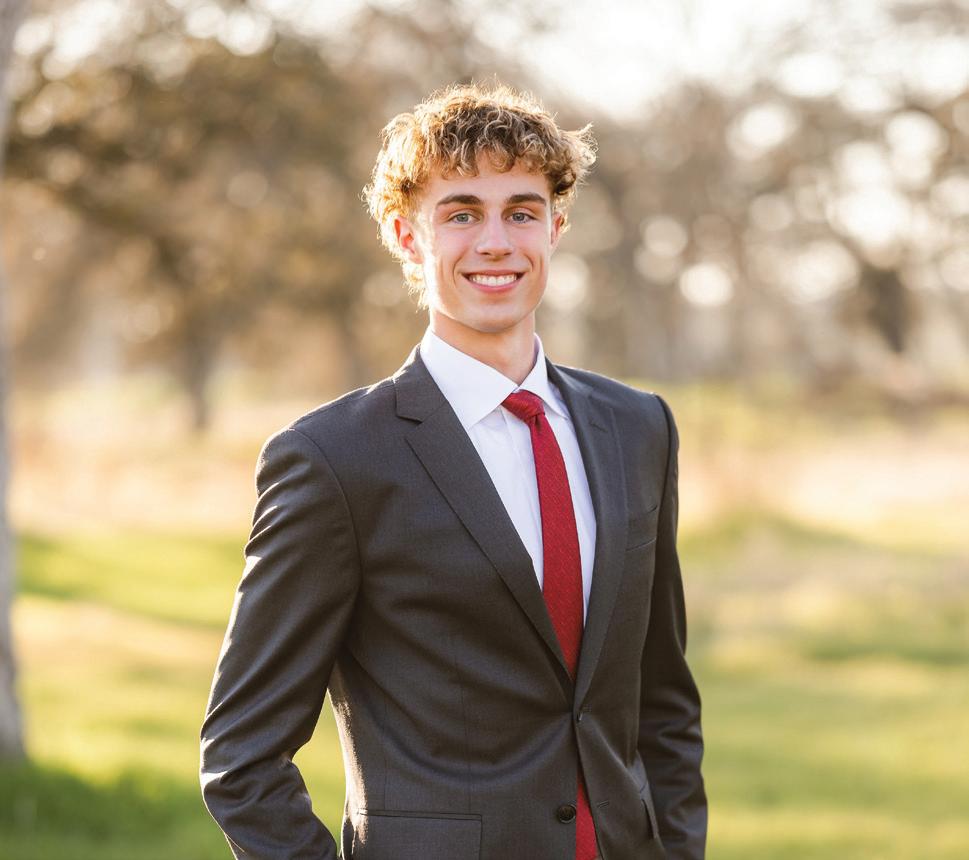
friends, Anika has shown me what it means to be a caring, sensitive and compassionate friend, both inside and outside Room 9.
No matter how busy she is with articles to write and pages to design, Anika will drop her work in an instant to support someone struggling emotionally. Whether it’s me or a staffer she isn’t as close with, she’ll be there.
Anika has taught me that a group of people cannot strive without empathy — that deadlines and page designs mean little if the people behind them aren’t cared for. I strive to provide the kind of support system that the entire Octagon staff receives from Anika.
Of course, emotional support is just one part of surviving in the newsroom — and in life. During my senior year, when school, college applications and extracurriculars became a swirl of stress, I found myself constantly on edge, running on fumes (and a LOT of Celsius energy drinks). Thankfully, there was someone who always reminded me to slow down.
Rehan taught me how to breathe.
On one of our many bus rides to the Bay Area for mock trial scrimmages, I frantically typed away on my laptop while others were peacefully napping or socializing. I knew I had overburdened myself, but I was determined to stay productive.
Suddenly, I started feeling ill. My throat went dry, my head felt like it was closing in on itself and a dull ache settled into my muscles.
I learned a term for this in AP Psychology — psychosomatic response. It’s when mental stress doesn’t just stay in your head; it seeps into your body, manifesting as physical symptoms.
Still, I continued to work with one hand, massaging my temple with the other.
That’s when Rehan spoke up. In his own way with words, he told me that I was overworking myself and needed to take life in.
“Stare out the window,” he said.
So I shut my laptop and looked out right in time for a perfect, golden sunset. I took a deep breath, and for a while, my symptoms diminished.
What I’ve learned from my fellow Octagon and mock trial colleague is something perhaps everyone needs to hear: sometimes, the most productive thing you can do is pause, breathe and look out a window.
But learning to pause doesn’t mean I stopped pushing myself. Because, as grounding as taking some breaks is, the grind is what brought me to where I am now.
Which brings me to my fellow Editors-in-Chief, Zema and Saheb — two of the hardest-working people I know.
What I appreciate most about Zema is her willingness to say yes. I’d be dreaming if I heard Zema turn down an opportunity to im-
Garrett and Aaryan. Distracted paste-ups and Sundays in Mock Trial with Mr. Hill. Regrettably scheduled Zoom meetings taken on the outskirts of campus.
Daily walks to-and-from school.
Soaking up sun in the quad.
Is that all? Is that really it?
My memory is like a filter. It picks up particles and leaves everything else behind. I hate that.
I can feel everything already starting to fade away, crowded out by recency bias and competing priorities. Inevitably, most of my memories from high school will eventually get filtered out even further, lost to the passage of time.
Given that, is it better to remember or to forget?
I’m tempted to hold on, to stay a little while. My freshman self? He certainly would want to. I remember him, watching my brother graduate. He was afraid to let go — afraid to leave high school before even starting.
If you’ve spent enough time with me on campus, you might recognize the brown H&M hoodie I used to wear to school in the colder months. On the front, its lettering reads:
“This is new and it’s not the same. Nothing ever can be. But it can still be better.”
That hoodie, ironically, has now lived out its life cycle — and corporate fast-fashion adages aside, I agree with it in spirit. Forgetting and letting go isn’t a failure of memory, but rather a condition of becoming someone new.
My high school experience isn’t merely the sum of the specific particles my memory will hold onto as I get older.
I’m a product of the journey, a gestalt of day-to-day experiences. No one moment, or a set of them, will suffice. And no single goodbye can contain everything I want to say.
The hedonic treadmill will keep running. My happiness will adjust to new circumstances, for better or worse. Life moves on.
So, met with the enormity of it all, of this “last goodbye,” only one emotion seems fitting: gratitude.
How lucky am I to have experienced something that makes saying goodbye so hard?
Thank you, everyone. Truly.
I have been at Country Day for essentially my entire life. I came here as a 4-year-old who couldn’t read and am leaving as an 18-year-old who can almost read proficiently.
When I look back, so many memories stand out — thankfully, most of them for the right reasons.
Whether it was my first Octagon paste-up, playing soccer out back with my friends or even popping confetti cannons in Ms. Jacobsen’s math class, this school has offered me so much, and I am truly grateful for it.
These weren’t just fun moments — they were the things that shaped me. I learned how to make friends, how to question authority (Ms. Todd would argue I got a little too good at that), how to think critically and — maybe most importantly — how to enjoy myself along the way.
Not every moment was easy. There were months — even years — when school felt overwhelming, when I wasn’t sure who I was (yes, I’m talking about when I made TikToks in seventh and eighth grade) or where I fit in. But those stretches taught me how to pull myself together and get it done.
Whether it was photographing plants during online school, grinding through a brutal DeltaMath in AP Calculus BC, or just trying to feel like I belonged, I always found support — from classmates who were struggling with the same things, and teachers who quietly pushed me forward, even when I didn’t realize it.
If I’m being honest, the thing I’ll miss most is the sense of familiarity that Country Day gives me.
prove the paper, whether it was tackling a difficult story or stepping in to redesign pages that needed an extra polish. If it weren’t for her, the quality of The Octagon wouldn’t be on the upward trajectory it’s currently on.
As for Saheb, it’d be an understatement to say he works hard. He’s a driving force.
Check the front page of any Octagon issue lying around — Saheb probably wrote one of the stories. And the quality of their first drafts? Nearly flawless. That rarely happens in a newsroom, but for Saheb, perfection is the norm.
If it weren’t for being surrounded by Zema and Saheb’s relentless drive, there would be moments I’d let myself take the easier path. But their presence reminded me of what a large part of being a student at Country Day means: rising to the occasion, meeting high standards and choosing growth over comfort.
And because I kept pushing, I’m grateful to say I’ll be spending the next four years exactly where I want to be — just like someone once predicted.
I have the utmost gratitude for the person who (repeatedly) reassured me that everything would work out in the end. He was right. Garrett taught me to believe in myself.
I know I just talked about how everything fell into place, but here’s a little insight into Ava’s mind until just a few months ago: it was filled with self-doubt.
Back in November 2024, I texted Garrett, convinced I’d be disappointed in my college decisions. His response?
“Stanford is next for u I believe it.”
That was a constant in our friendship — him believing in me more than I believed in myself.
The sleepless nights wondering if I was doing “enough” for my college apps, the frustrated sighs over any sub-A test grade — all of it eased by Garrett’s steady assurance that I’d be OK.
When I finally opened my acceptance letter, I couldn’t help but think: I would’ve enjoyed the journey a whole lot more if I had just believed in myself the way he did.
So, to all the freshies reading this: listen to Garrett. You are enough. Your grades, extracurricular activities and passions — everything is enough if you’re giving it your best shot.
The doubt will creep in, the pressure will pile up, and there will be moments you want to quit. But keep showing up. Take care of yourself — and others — like Anika. Learn how to breathe like Rehan. Give it your all like Zema and Saheb. And believe in yourself like Garrett did.
A final thank you to everyone I’ve shared late nights and laughter with in Room 9 — you made this more than just a class. You made it home.
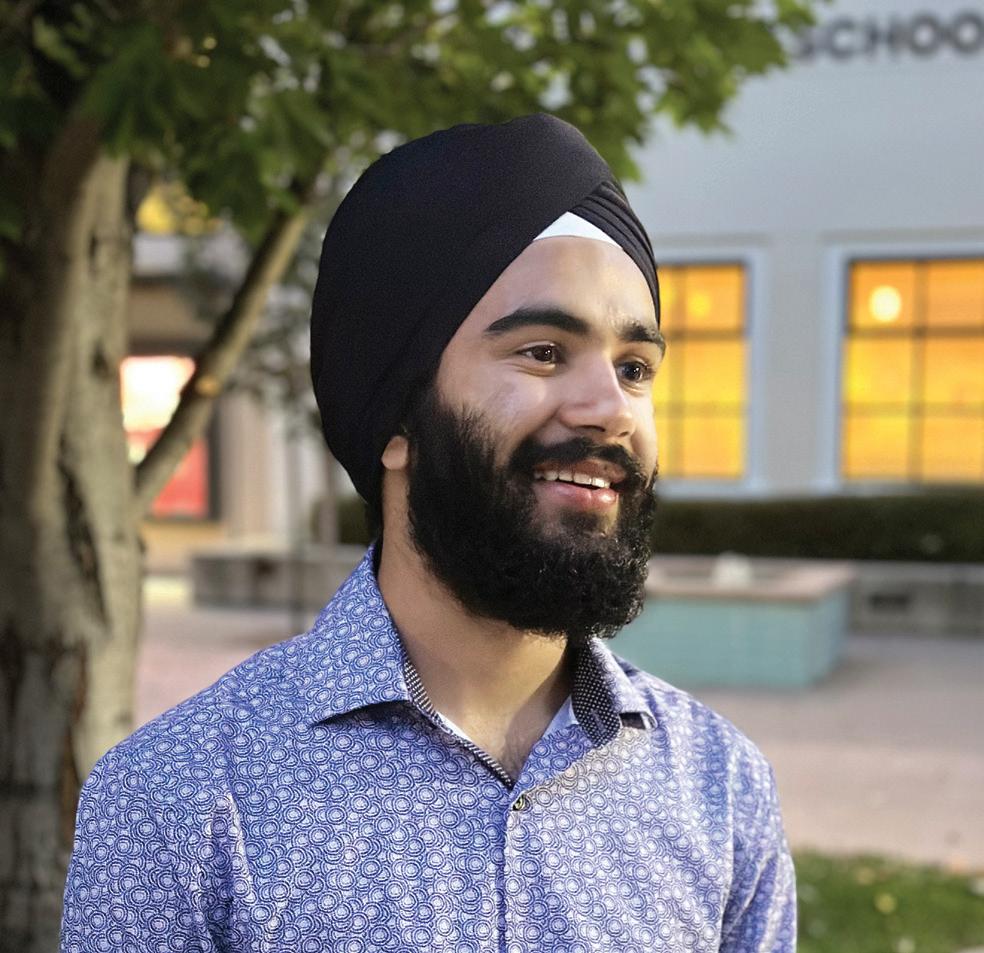
For the big favors and shared victories, the small pieces of advice and consolation. For meeting me where I was, and helping me become who I am. For letting me get a small glimpse into your brilliant, unique worlds.
It’s been real.
Thanks to you, I’m ready for the next journey.
To move forward while honoring what came before. To make new memories. To be a small fish in a big pond (or a small tree in a big forest?) this fall at Stanford.
It comes from everything: the people, the work, the location — even the hole I accidentally made in the gym ceiling with an errant soccer ball a few years ago.
After doing some rough math: 170 school days a year, seven hours a day, for 14 years — plus extra time for sports and activities — I’ve spent about 16,800 hours at this school. That’s roughly 17.5% of my waking life.
Even factoring in my (at times) questionable attendance, it’s still a huge chunk of my time on Earth. I owe a lot to the people here. To every teacher who gave feedback that actually made me think. To every friend who stuck with me through some interesting times and eventually saw me become
“The Drew.” To my coaches, especially Coach Rick and Coach Vargo, all my past and current EICs and Ms. Todd — you all contributed to more than just my awesome LinkedIn profile. You shaped who I am. I probably didn’t say thank you enough during my time here, but I mean it now.
From here on, that percentage will only shrink, and so will Country Day’s role in my day-to-day life.
But using one of the few things I remember from AP Calculus AB — shoutout Mr. French — I know that while this percentage may approach zero, it’ll never fully reach it.
Country Day may become a smaller part of my life from here on out, but it’s built into the foundation. And like any good foundation, it’ll be holding me up for a long time to come.
It was a warm spring day, and the Petroglyph Ceramic Lounge was immediately cool and soothing. Sunlight poured through large windows, filling the space with natural light. People sat comfortably at large tables in green and blue booths. Lively music played in the studio, accompanied by the sounds of low chatter and paint brushes in action.
If you are looking for a fun activity on a hot summer day or an opportunity to create a personal gift for someone you care about, Petroglyph Ceramic Lounge is the perfect place to go. Just four minutes away from Sacramento Country Day’s campus, located in the Pavilions Shopping Center, you can customize your own pottery from a variety of selections.
The name Petroglyph comes from ancient rock carvings, often featuring symbols, designs, or figures etched into the surface of natural rock.

According to the Petroglyph Ceramic Lounge website, Jennifer Rubin started the ceramic lounge as a place for adults and children to “ideate, socialize, and paint original ceramic pieces.”
The company was created in 1993, with the first Petroglyph location opening in Santa Cruz, California followed by studios in Los Gatos, Roseville, San Jose and Sacramento.
Junior Chloe Zhang accompanied me to the Petroglyph Ceramic Lounge on a Saturday afternoon. As soon as you walk in, you see a wall filled with various ceramic pieces, ranging from keychains and bowls to plates and cups. Prices range from $5 to $50. In the center of the room are all the paints and supplies you will need to customize your pottery.
Prospective ceramic artists purchase a Studio Day Pass — $15 for those 13 and older and $13 for those under the age of 13. The pass al-
lows you to utilize all the supplies Petroglyph Ceramic Lounge offers, including firing and glazing.
“When I first walked in, it was an immediately peaceful place. I was amazed by the variety of ceramic pieces to paint. I was excited for this first-time experience,” Zhang said.
After selecting our pottery, we were able to choose from over 80 different paints and a variety of tools and paintbrushes to customize our piece.
We chose our paints from glazed tiles, which showed what the color looked like out of the kiln. This is important because colors can look dramatically different after being glazed and coming out of the kiln.
The glazes are food and drink safe after firing, so they can be used for everyday purposes.
Next, we selected from a variety of booths and high tables to sit at.
As we started working on our ceramic pieces,
an older woman would periodically come to our booth to look at our projects.
“I always love to see what other people are making,” she said.
In my experience, Petroglyph Ceramic Lounge’s best quality is its creation of community among customers.
Artists of all ages were in the studio. There were lots of families, friends and grandparents there.
Everyone was kind and always wanted to see what we were making and were willing to help you find materials for your ceramic piece.
The staff was also very friendly and would check in to ask if we needed anything.
While painting, we were treated to a playlist on the speakers meant to liven the atmosphere while maintaining a tranquil, creative space.
I painted an ocean-themed mug with different blues and greens on the outside and pink flowers on the inside.
My mug turned out perfectly. The blues and pinks that I used were ocean, purple haze, lavender, deep pink, flamingo, melon and peach. These colors all came together to form the exact beautiful ocean effect that I wanted.
After I completed my piece, the staff described how I painted my ceramic so they could identify my piece when I came back to pick it up.
It took three days before I could come back and pick up my ceramic, during which time the staff fired your piece in the kiln.
Even if you are brand-new to ceramics or painting, Petroglyph Ceramic Lounge is the place to discover your inner artist, create something meaningful and relax with the people you care about. It’s a perfect place to create memories while having fun in an art-enriched, creative, welcoming environment.

On the teaser track for Kali Uchis’ new album “Sincerely,”, the last song, “Sunshine & Rain…”, opens with the line “Good morning, sunshine.”
This line is from an audio clip of Uchis’ son being baby-talked to by his grandmother — who had died just a few months after her grandson’s first birthday.
Uchis is a Latin-American R&B singer and songwriter who has won one Billboard award and been nominated 5 times for the Latin Grammy Award. She has 38 million monthly listeners on Spotify and is best known for her songs “Moonlight” and “telepatía.”
Uchis’ newest album, “Sincerely,” released on May 9, was written and inspired by two events that changed Kali’s life: the birth of her son and the death of her mother.
Uchis’ son’s birth and mother’s death happened just within a year of each other—her son being born March 2024 and her mother passing May 2025.
After her mother’s death, Uchis dedicated “Sincerely,” to her late mom.
As a long-time listener of Uchis, I find her music truly special because, to me, it serves as a reflection of the beautiful blend of Latin and American music in pop
culture today, tied to my identity as a Latin American. My favorite songs of hers are “Te Mata” and “No Hay Ley Parte 2” from her album “ORQUÍDEAS.” I have been to her concerts while she was pregnant with her son, and she was my No. 1 played artist on Spotify last year — although I have been listening to her since 2023.
For this review, I am focusing on the teaser track, pre-released from the album the first track on the album and what is in my opinion the most interesting song on the album, respectively, “Sunshine & Rain…”, “Heaven Is A Home…” and “Silk Lingerie,.”
“Sunshine & Rain...” “Silk Lingerie,” “Heaven Is A Home...”
“Sunshine & Rain…” is the first song released as a teaser from Uchis’ new album “Sincerely,” on March 27, over a month before the official release of the album on May 9.
The line “Good morning, sunshine,” said by Uchis’ mom to her newborn grandson, sets the mood for the rest of the song.
Both the rhythm and lyrics of “Sunshine & Rain…” are heavily emotional and have deeper meanings beneath their surface. Even the title of the song hides some nuance.
Her son’s birth is the “sunshine,” and her mother’s death is the “rain.”
Just like the opening line, “Good morning, sunshine” the rest of the lyrics of the song are soulful, but at the same time, I feel like it’s a call to action for humanity.
Throughout the song, Uchis talks about humanity, preaching that the world needs to change for the better.
Uchis sings, “Like, whatever happened to the human race? / Did everyone’s brains get melted and deranged? / Bitches backwards to me / When was it that your lost your common sense?”
Uchis’ frustration with the current state of the world, and humanity as a whole adds to a unique experience listening to this song.
As a long time listener of hers, I’ve never seen her sing this way. “Sunshine & Rain…” is so raw, so unrestrained. The song is passionate yet humble, heavily emotional yet calm.
I recommend anyone who loves soulful music listen to it.
Rating:





I imagine “Silk Lingerie,” as the perfect song for the opening of a thriller or mystery show with a female lead playing a dangerous character. It’s slow, suspenseful and graceful.
The consistent echo of Uchis’ lines adds to the mysterious ambience of this song, making it truly enigmatic and captivating for the listener.
While the mood of the song is truly mesmerizing, there’s nothing particularly interesting about the lyrics to me. They’re vague, and frankly, too slow to fully understand.
Uchis’ lines in “Silk Lingerie,” often extend over eight seconds, which compared to other songs in her album like “Sunshine & Rain…” is twice as long as her average line.
The lyrics of “Silk Lingerie,” are almost incoherent and too close to mumbling to be considered a particularly outstanding song.
I wouldn’t mind hearing this song at the beginning of a good Netflix show about a woman who leads a regular life as a housewife by day, and a high-skilled jewelry robber by night, but I wouldn’t go out of my way to listen to it on my own time.
Rating:





When I first listened to “Heaven Is a Home…,” I thought the song was meant for her newborn son.
The first lines of the song are very slow-paced, as Uchis sings, “Hey, could you quiet down? / There’s too many sounds / And the world could really use some rest.”
Initially, this made me think the song was made as a lullaby for her baby, but after further listening, you can tell it’s far from that — it’s a cry for help and a plea for safety and privacy.
As the song continues, Uchis passionately sings, “Tired of the world / They’re on my last damn nerve / . . . / Stay away from my baby / Stay away from my home / That’s all I ask of the world / That’s all I ask of you,” a reference to how paparazzi and the public encroach on her and her new baby’s privacy.
These lines and impassioned lyrics demonstrate the emotional toll caused by the relentless intrusion of the media.
“Heaven Is a Home…” is Uchis’ attempt to protect what matters most to her: her family.
As the listener, this protective instinct heavily resonates with me, making for a truly emotional listen, moving me closer and closer to tears.
Although Uchis expresses frustration through the lyrics, the same anger isn’t reflected through the slow and calm rhythm and melody of the song.
The beautiful harmonization and the strung out lines in “Heaven Is A Home…” contrast beautifully with the resentment expressed in the lyrics.
The new degree of frustration that Uchis writes within her new album is something I’ve never seen before as a longtime listener, further transforming the experience of listening to this new album.
Although “Heaven Is a Home…” is a little too slow for my taste, these contrasting emotions make the song an eye-opening listen once you can fully understand the lyrics within their context.
Rating:








Add some cinematic excitement to your summer nights with these upcoming blockbusters! The themes of these movies are about revivals and adrenaline. Many of them are based on previous works,
whether they are sequels or live-action adaptations. Immerse yourself in these fantasy worlds and action-packed movies. Grab your popcorn and get ready for a thrilling summer.




The upcoming Formula 1 (F1) movie covers a retired F1 driver (Brad Pitt) who gave up driving after a horrible crash, and chooses to mentor a young, aspiring driver (Damson Idris).
This movie was co-written by Joseph Kosinski and Ehren Kruger, the team responsible for Top Gun 3, currently in development. The first trailer for the F1 movie was tailored to release three days before the 2025 Australian Grand Prix.
13
The beloved animated movie is getting a live-action treatment. The movie is shot in IMAX, and the sense of immersion is straight to the fullest. Dean DeBlois returned to direct, write and produce, once again telling the adventures of the originally incompatible humans and dragons in a fantasy world. The film is set to focus on the friendship between Hiccup (a young Viking) and Toothless (a dragon) and their adventure together.


F1: The movie





11
The new Superman movie, starring David Corenswet, shows the cultivation of reporter Clark Kent (Corenswet) as he reunites with his Kryptonian heritage. James Gunn, director of 2014’s Guardians of the Galaxy, wrote and directed this movie. Gunn was inspired by All-Star Superman, a twelve-issue comic book series. Gunn revealed in a Variety interview that the film was inspired by his late father’s support of his love for comic books.

2
Original Jurassic Park screenwriter David Koepp returns, but with a new cast and storyline, which takes place five years after Jurassic World Dominion (2027). The dinosaurs survive on an isolated island, but there is a key gene in them that can dramatically advance human medicine. In order to obtain the gene, an elite team infiltrates into the forbidden land of the dinosaurs, but what is waiting for them is an unpredictable crisis and a shocking conspiracy.




